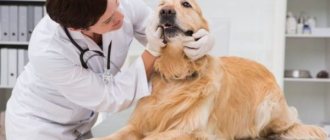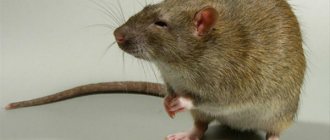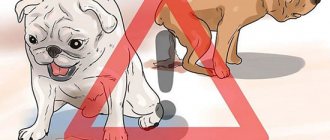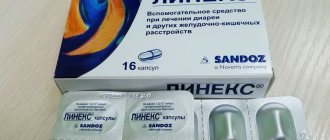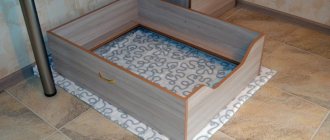How to tell if your dog is constipated
Constipation is difficult or infrequent movement of masses in the intestines. And this is the most common disease associated with the digestive system.
Telltale signs of the disease include:
- dry, hard stools;
- straining when trying to defecate.
Some dogs may also produce mucus when trying to poop. If there is no stool for 2 days, then this condition is considered to be constipation. The animal tries to relieve itself, squats, but nothing happens, which means it definitely needs help.
Did you know? The most common cause of constipation in dogs is their diet and food selection.
Why does it appear
Under normal circumstances, feces pass through the digestive tract and end up in the colon. There, water and electrolytes are extracted from them and absorbed through the mucous membrane.
Reabsorption of water is the main function of the colon. The fecal material in it moves through a process known as “peristaltic waves.” If it is disrupted or slowed down, fecal matter gets stuck in the colon and continues to lose moisture. At the same time, it becomes hard, dry and eventually stops, forming a plug.
There are various reasons why a dog may develop constipation:
- excess or lack of fiber in the diet;
- too little exercise;
- blocked anal sacs;
- enlarged prostate gland;
- Excessive licking of fur and intense shedding can also lead to the accumulation of large amounts of hair in the stool and fecal plug;
- matted fur around the anus due to lack of grooming or obesity;
- stones, bones, plants or pieces of toys that have entered the intestines interfere with the attempt to poop;
- large tumors in the anus or rectum that cause an obstruction (blockage);
- side effects of medications;
- pelvic trauma;
- an orthopedic problem that causes pain when the dog sits up to pee;
- neurological disorder;
- dehydration due to another illness;
- condition after surgery;
- poor diet with insufficient fluids.
Older pets will be more likely to suffer from constipation. Their gastrointestinal muscles do not function well and they are unable to go to the toilet regularly. However, the condition can occur in any dog that has one or more of the causes for constipation listed above.
Important! To prevent constipation, provide your dog with constant access to clean drinking water. The animal should not suffer from dehydration.
Poor nutrition
Dogs learn about the world by testing objects. Therefore, sometimes completely inedible things are swallowed and this leads to blockage (intestinal blockage). The most common culprit of pathology is bones. Some fragments are not completely digested and can also cause constipation.
If possible, use chicken necks. They are much healthier than any other bones. They contain substances necessary for the creation of joint tissue (cartilage).
Dogs, like people, need fiber to form stools. Diets lower in grains and carbohydrates and higher in protein and moisture often result in hard stools. Complex grains such as oats, peas, barley and sorghum are high in fiber and can be used to alleviate the problem.
The bacteria that live in your pet's intestines play an important role in digestion. Their balance is influenced by diet, composition and type of food. Bacteria adapt to digest certain foods that are supplied regularly. And if you suddenly change your diet, problems are possible: diarrhea or constipation. Therefore, it is always important to introduce a new food in small portions.
Sedentary lifestyle
If a dog stays indoors for too long, doesn't move much, and feces remain in the rectum for a long time, it will become hard. Avoid such situations. Walks should be regular.
Use of medications
Constipation can be a side effect of taking medications. For example, antibiotics. They disrupt the normal bacterial population in the intestines and cause constipation. Supplements containing iron cause hard, very dark-colored stools.
Some herbs are also toxic. Nettle, alfalfa, and flax cause digestive upset. Vitamin C in the form of ascorbic acid is poorly tolerated by the stomach. Oil-based vitamins E and A always soften stool, as do all oils. A large dose of vitamin B will cause diarrhea and vomiting in your pet.
Important! If you notice that after taking the prescribed medication, problems with bowel movements occur, then you need to discuss this with your veterinarian and replace the drug with another one.
Possible diseases
Dehydration or insufficient fluid intake from food often causes constipation. In older animals, the problem is due to the fact that they simply drink very little. If constipation occurs regularly, but there are no other symptoms of illness, then simply add more moisture-rich foods to your pet’s menu.
Any disease that affects the intestines, including parasites, can cause constipation:
- Infection with parasites (roundworms) of the digestive tract occurs in young dogs. A ball of roundworm can block your puppy's intestines and cause serious problems, including distension of the intestines or compression of other organs.
- Malignant neoplasms, ulcers, tumors, food allergies, bacteria, viruses or other pathologies are also accompanied by constipation.
A dog doesn't whine for no reason
A dog never whines without a reason, this is how the dog tries to attract attention to itself, the reasons for whining can be pain, some emotional states, owners need to learn to understand the dog’s language.
Active dogs are often bored; the animal can wander aimlessly around the apartment, or lie down, apathetically staring at one point, while whining over a toy, fetching a leash, or pushing a person towards the door. Pets almost always begin to squeal with joy when meeting their owner, after receiving their favorite treat.
The dog whines and hides - this is how the animal asks the owner for forgiveness for an offense, expresses its respect, recognizes the primacy of the person, or it is simply scared.
A suddenly awakened hunting instinct is the reason for sudden loud barking, whining, the dog may see birds or a cat on the window, whining expresses annoyance, the prey is close, but it cannot be reached.
Whining during a walk begins if the animal is cold or hot and wants to return home. Or, conversely, the pet feels that the promenade is ending and asks the owner for a little more time.
Dogs do not tolerate loneliness well; a puppy, and even adult pets, whine when left alone in a car, apartment, or any enclosed space if the owner leaves.
Whining and squealing early in the morning is a sign that your pet needs to go to the toilet, is frozen or thirsty; dogs may run to the door, try to get under a person's blanket, or poke their muzzle into the water bowl. But often pets begin to whine when they are sick; females almost always whine during estrus, after giving birth, if the puppies have died.
Why does a dog whine and not bark?
- if a male dog is running, whining and howling on the street, then there is a dog in heat nearby;
- the pet itches and whines, but there are no fleas - the cause may be skin diseases, insect bites, you need to carefully examine the animal's fur and skin;
- the dog does not eat anything and whines in the morning or evening - this may be due to constipation, poisoning, the pet is tired of its usual food, or it is simply hot outside, the animal has no appetite;
- the animal scratches its ears and whines - the dog was bitten on the head by an insect, water got into the ears, or inflammation in the hearing organs began; a veterinarian will help you find out why the dog whines when it scratches its ear;
- the dog begins to whine after eating - this is the first sign of gastritis, peritonitis, ascites, and the presence of neoplasms in the gastrointestinal tract;
- the dog whines when he goes to the toilet for a long time - this often occurs due to intestinal obstruction, proctitis, colitis;
- the animal whines when it pees - you need to check the genitourinary system, dogs often develop cystitis and stones form in the bladder;
- the dog whines and bites its tail, behaves restlessly - similar symptoms occur when there is a large accumulation of worms in the body, additionally there is diarrhea or constipation, causeless vomiting, shortness of breath, cough, the appearance of the coat deteriorates;
- the pet shakes, whines when you pick it up, there are convulsions, increased salivation and foam at the mouth, the pulse quickens, breathing becomes heavy - all these signs indicate poisoning with chocolate, water, chemicals or toxic substances.
Animals can have dreams, not always pleasant ones; at such moments the dog twitches and whines in his sleep, he may wake up and start running restlessly. Whining, squealing and barking at night by a pet often occurs in unison with yard or neighbor animals.
The puppy whines at night when he is taken away from his mother - the baby is under severe stress, he is scared and lonely, crying can be caused by hunger or cold. The biggest and most common mistake owners make in such cases is to take their pet to bed. The dog will soon grow up, but the habit of sleeping in a human bed will remain.
There are many reasons that make a dog whine. They can be associated with physiological needs, psycho-emotional state, illness and gaps in education. Depends on age and temperament.
Whining is a great way of manipulation, be careful
A dog is considered a pack animal, and therefore the sounds that a dog can make are a way of expressing one’s own feelings, transmitting certain information to people. It turns out that the dog mainly begins to whine for fairly logical reasons. If you take care of your own pet, then never ignore his cheekbones.
With small puppies everything is quite clear. Pets, when they develop, need care, love, and attention from the owner. Puppies also need regular walks, food, and drink. If you do not monitor this, the puppy will constantly whine, squeak, and cry.
Pet
However, if an adult dog whines, then this may be a sign of some kind of problem. You will have to identify this problem in order to solve it immediately.
If your dog whines, never panic. You just have to discover the reason why the dog is behaving this way. Don't ignore the sounds it makes. Initially, take the animal to the doctor. It is possible that your pet has health problems. Of course, this reason does not apply to those four-legged friends who whined from an early age. But if the dog starts whining unexpectedly, then you should be wary.
- Try to monitor how the animal behaves so that it does not suffer from a serious illness. For example, if your pet has problems, he begins to limp, it is difficult for him to get up and take a lying position, then, most likely, the dog was injured. Perhaps your four-legged friend has problems with his paws.
- The dog may also be concerned about: gums, teeth, injuries that have occurred in the oral cavity. It often happens that some sharp object causes discomfort to your pet. It can injure the gums or even break a tooth.
- It is quite possible that problems have arisen in the reproductive or urinary system. And, if you do not pay due attention to your own pet and its health, the diseases that you develop will develop into more serious pathologies.
- Your pet may have become infected with parasites. They can torment a pet, and therefore be one of the main reasons why a dog whines and constantly cries.
- It is also possible that you are not feeding your dog the right food or are not monitoring his health. You should know that dogs can also very often be bothered by constipation, as a result of which they whine just like that.
We suggest you familiarize yourself with How to recognize rabies in a cat, signs by forms of the disease
Whining There
are also other possible factors associated with various diseases and injuries of your four-legged friend. They are the ones who force the pet to whine, just squeal, and cry.
You can independently determine at home the main reasons why your dog whines. However, there are situations when it is impossible to do without the help of a professional veterinarian. Carefully feel all the places where injury may occur. The dog will definitely react to your touch when you touch sore spots.
There are individuals who have high nervousness, restlessness and anxiety, and therefore they constantly just whine. Such problems can greatly ruin people's lives, as animals whine and bark, even when a slight noise occurs.
Remember how many dogs whine when fireworks, firecrackers or other pyrotechnics explode. Your dog may whine if you leave the house or leave your pet alone for a long time.
We offer you some top tips:
- Of course, in order to rid your dog of fears, you will have to be patient and time. For example, your dog is very afraid of thunderstorms, and therefore he howls and whines. Play the sounds of wind, rain, and various natural disasters more often. Also don’t forget about the sounds of thunderstorms and sea waves. Or you can play a calm melody for your pet in his own language. However, initially turn on the sounds quietly, then over time you can increase them. When the music plays, pet the dog, tell your pet that the thunderstorm is not so scary at all, it does not threaten his life at all. You will definitely see results if you turn on sounds regularly. Over time, the pet will get used to these sounds and will no longer whine or cry so often.
- A dog whines when her puppies are taken away from her. She wants to “say” in this way that her children will be returned to her, that she misses them, is sad and worried. In addition, dogs may whine regularly if they are in heat - this is considered normal.
- Sometimes it happens that boy dogs whine because they recognize the leadership of the other dog, and therefore beg him to reconcile.
- A dog may also whine if the owner punishes him for a certain offense. This is how the pet tries to show that he admits his own guilt, agrees that it is his owner who is considered the main one. The whining will disappear very quickly when you pet your pet.
- A small dog whines if he wants to play a little. It often happens that a dog whines if it lacks human attention. This suggests that the pet simply misses its owner. You can say some kind words to your pet. Go up to him, scratch behind his ears, pat his withers. This will all be appropriate, but do not forget to give the dog some kind of treat after your petting, for example, a bone or meat.
It is the hunter's instincts that make the dog whine. Basically, in dogs they occur when they detect prey, for example, a fox, which they simply cannot get. Another target for dogs can be a squirrel, a bird or a cat in a tree. It will be difficult for you to correct such a problem, since it is in the genes of dogs. However, you will still be able to do something.
How do symptoms appear?
Constipation is expressed not only in the absence of bowel movements in the dog, but also in the type of stool. They are usually hard, dry, and sometimes pebble-like. There are a number of signs that may accompany constipation and are considered important for diagnosing the disease:
- Tenesmus is a burning pain in the rectum; the presence of this symptom indicates that the patient has one of the gastrointestinal diseases: colitis, gastroenteritis, gastritis, gastroenterocolitis;
- dyschezia is a condition in which a dog is unable to poop due to muscle or sphincter problems; at the same time, there is a feeling of incomplete excrement of feces, and the pet, which has already pooped, sits down, as if it were going to continue.
Did you know? The ideal mince for dogs contains about 10% bones. Although your pet can eat more seeds, you should not abuse them.
Common symptoms of constipation include:
- tense stomach;
- lack of appetite;
- slouch;
- thirst;
- sporadic vomiting;
- mucus in stool;
- whining;
- lethargy.
But all these symptoms do not necessarily accompany every case of constipation.
How to help a dog at home
Depending on what is causing your dog's constipation, your veterinarian may recommend one or more at-home treatments. This is an approximate list of actions for the owner of a sick animal:
- Make sure your pet has enough water. Access to it must be constant. If necessary, make up for its deficiency with wet food. This is especially important for older dogs who drink and eat less than they used to. If the diet included dry food, replace it with wet food from the same manufacturer.
- Alternatively, try adding a little water or broth to the food if your dog is fed natural food.
- Assess and adjust the amount of fiber you consume. It could be pumpkin or other vegetables. Psyllium seed husk is rich in fiber and is used in the presence of disorders of motor activity of the gastrointestinal tract. Mix 1/2 teaspoon of raw material with water and add to food.
- Regular exercise promotes peristalsis. Therefore, increase your pet's physical activity.
- If everything is normal with water and fiber, but the dog does not poop, then add oil to the diet. It can be sunflower, olive or any other. For a small dog you need 1 teaspoon, and for a large dog - up to 1 tablespoon. You can buy castor or vaseline oil at the pharmacy. Dosage - 1 tsp. per 10 kg of pet's weight. You can use the drug up to 2 times a day.
- If all of the above doesn't help, try a laxative or stool softener. Sometimes drugs are used to increase the number of colon contractions.
- If the pet is straining, but cannot poop, then an enema is urgently performed.
If constipation is not relieved, a more complex problem may develop: the inability to empty the colon on its own. In this condition, the intestines become filled with large amounts of feces, causing muscle tension, lethargy, loss of appetite, and possibly vomiting.
Important! If constipation has just appeared (the dog does not go to the toilet 1
–
2 days), then home remedies will be effective and appropriate.
You just need to take into account that the same strategy does not work equally for all animals, so if there is no result ,
try another remedy.
Rules for giving an enema
Begin the procedure by preparing the instrument. There are several ways to give an enema. The first is using a plastic syringe that will hold 2-3 tablespoons of liquid. This is a practical solution for small dogs. The second is a regular enema. It is used for medium and large animals.
The water for the procedure should be warm, but not hot or cold. The optimal temperature is the dog’s body temperature +38°C. You can add to it:
- a couple of drops of lemon juice;
- a pinch of salt or potassium chloride.
These are electrolytes that will help restore water balance in the body. But to relieve constipation, you can use just warm water.
Instructions for enemaing a dog:
- Stir the liquid thoroughly and check if it is hot.
- Fill the syringe or enema and lubricate the nozzle with vegetable oil.
- Gently insert the tip of the enema into the rectum.
- Hold it in place and slowly squeeze the contents into the anus. The pressure should be uniform. If the water doesn’t come out, just change the angle of the tip.
- Remove and, if necessary, massage your pet's belly to stimulate peristalsis.
- The result should be obtained within 5–10 minutes. If nothing happens, then you can repeat the enema.
Important! If we are talking about therapeutic enemas for severe constipation, then the procedure is repeated every 4 hours.
What medicines can be given
Treatment will be aimed at a number of goals, regardless of the severity of constipation, namely:
- bowel movement;
- resumption of intestinal transit;
- restoration of fluid and electrolyte balance disturbed due to constipation.
Emptying your dog's bowels will be a simple or complex process, depending on the severity of the disease. There are quite a few drugs available for treatment. You can choose any of those available at the veterinary pharmacy. But before you buy, consult your veterinarian.
If the blockage occurs in the small intestine, laxatives or saline solutions are recommended. Restoration of acid-base and fluid balance is carried out using infusion solutions based on carbohydrates, vitamins, minerals and amino acids.
Here are some medications that can be used to treat your dog:
| Drug name | Purpose and dosage | Peculiarities |
| "Duphalac" | Dilutes stool and normalizes intestinal microflora. 0.5–1 ml/kg dog’s weight 2–3 times a day. | Can be given pure or diluted with water; instill into the mouth with a syringe or mix with food. |
| "Mikrolaks" | The contents of the tube must be inserted into the rectum. | The drug is presented in the form of tubes for enema. Can be used for dogs and cats. |
| "Lactusan" | Available in the form of syrup, as well as suspension and tablets. 2–3 ml/kg per 1 dose. | Take 2 times a day. It is recommended to take the medicine after meals. |
| "Bimin" | A medicine with a laxative effect. Packaging: single dose vials. 0.5–1 ml/kg dog weight 1 time per day. | It is advisable to give in the morning before meals. |
| "Senade" | Laxative. For small dogs - 1 tablet. For large ones - 2 tablets. | It is recommended to give before bed in the evening. It is prohibited to administer to animals with kidney disease. |
| "Magnesium sulfate (magnesia)" | Has a liquefying effect. 1–2 g for a small dog and 4 g for a large one. | The product acts slowly, so it can be given 4-6 hours before bowel movement. It is forbidden to use for cholelithiasis and kidney diseases. |
| "Bisacodyl" | Means for improving peristalsis. A laxative that increases mucus production and thereby improves intestinal motility. 0.15–0.3 mg (1 suppository) 2 times a day. | Do not use if there is intestinal obstruction (bone blockage) or bleeding. Acts slowly. The effect will appear in 5–7 hours. |
Folk remedies
Traditional treatments for constipation include herbs and certain foods. For example, ginger, wheat bran, powdered psyllium seeds and olive oil.
Basic herbs and their uses:
- Powder of dried leaves or seeds of plantain is purchased at the pharmacy. For dogs up to 10 kg you need 1 teaspoon of seeds, from 10 to 20 kg - 2 teaspoons of seeds, from 30 kg - 3 teaspoons.
- Boiled pumpkin is added to porridge. Dosage 1 tablespoon for pets weighing up to 10 kg, 2 tbsp. l. for dogs weighing from 10 to 30 kg and 3 tbsp. l. for animals weighing more than 30 kg. Repeat 2-3 times a day.
Herbs help with constipation, but you should still consult your veterinarian to ensure you don't miss the onset of another serious illness.
Important! If there is a foreign body in the intestines
—
Do not give your pet water or food until examined by a doctor.
What to feed your dog
If your pet's condition is chronic, a balanced diet is recommended. Feed cooked meals, they help the intestines work.
Use the following supplements and enhancements:
- Cellulose. In the natural environment, it enters the predator’s body along with the fur of the prey. But at home, meat products do not contain wool. Therefore, add vegetables (pumpkin, carrots). 1 tbsp is enough. spoons 2-3 times a day with food.
- Add 1 teaspoon of apple cider vinegar to your drink. It improves digestion, including relieving constipation.
- Chopped prunes work well. It is cut into pieces, poured with boiling water, left for 2-3 hours, and then the decoction is added to drinking water.
- Fermented milk products, such as kefir, can also help normalize stool.
If your dog develops diarrhea after constipation, solve the problem by adding 2 teaspoons of mineral oil to his food twice a day for a week.
Also keep in mind the dog's age. If this is an animal over 8 years old, then it needs a special diet to prevent age-related diseases. These are high-quality natural food in small portions, 3-4 times a day or industrial canned food for pets with gastrointestinal diseases.
Treatment
Treatment methods for increased urination are determined after identifying the cause. To do this, the veterinarian diagnoses the animal’s condition. Non-dangerous causes of pathology are eliminated at home.
If your puppy urinates frequently, it is important to get him accustomed to the process of going to the toilet. Over time, the animal will get used to relieving itself twice a day outside.
Other conditions can be treated as follows:
| Causes of frequent urination | Fighting methods, therapy |
| Drink plenty of fluids | If your animal is drinking a lot of water due to the heat, you should move it indoors and turn on the air conditioning. It is advisable to replace dry food with homemade food |
| Low temperature | There are special clothes for dogs for walking outside. There are dogs that are cold even at home, so it is important to monitor your pet’s condition to avoid hypothermia |
| Fear and stress | The veterinarian prescribes antidepressants, but it is best to provide the dog with a calm living environment |
| Excitation | This often happens when a dog changes its place of residence. During this period, you should treat your pet with understanding. |
| Desire to mark territory | Reduces libido and the desire to mark possession by castration. In some cases, you can limit yourself to re-education |
| Age | Treatment of the condition in older animals is with supportive medications prescribed by a veterinarian. If there are contraindications, the problem can be solved with the help of diapers |
| First heat | No treatment required, frequent walking of the dog is required |
To eliminate pain in the bladder, you need to find out the cause, which is done in the veterinarian's office.
Therapy of pathological conditions
Treatment of diseases in a pet should be carried out under the supervision of a veterinarian. Otherwise, the condition may worsen.
Disease therapy is described in the table:
| Disease | Treatment methods |
| Cystitis | Use of certain groups of drugs:
|
| Polydipsia | Treatment depending on the cause of increased water consumption. For serious kidney problems, a synthetic antidiuretic hormone is administered |
| Injuries | In the initial stages, you need to relieve inflammation and pain with drugs:
|
| Ectopia | The only treatment is surgical: insertion of the ureters into the bladder |
| Diabetes insipidus | Prevention of heart failure, administration of Vasopressin and correction of the ionic composition of the blood |
The use of drugs in any situation is agreed with the veterinarian. The doctor prescribes dosages and frequency of administration. Side effects, contraindications and symptoms of overdose are indicated in the instructions for each specific medication.
The problem of frequent urination in dogs is familiar to many breeders. If a dog urinates frequently, its owner should understand the reasons to rid his pet of this problem. Detailed information regarding this issue is provided below.
When to contact a veterinarian
If constipation lasts longer than 2 days, then the dog should be taken to the veterinarian. Especially if there are other symptoms:
- blood or foam in stool;
- putrid odor in feces;
- vomit;
- respiratory symptoms;
- lethargy and apathy;
- lack of appetite.
Most dangerous diseases are diagnosed only through tests. Without consulting a doctor, it is impossible to determine how serious the condition is. Therefore, it is imperative to know the exact diagnosis and receive a course of treatment. It is easier to cure a disease that is detected at the very beginning of its appearance.
Did you know? Strange, but pumpkin helps both constipation and diarrhea equally well. It has a lot of fiber, moisture and most dogs like it.
Health problems
Why else can a dog have incontinence - it is due to illness. As a rule, such diseases are caused by inflammatory processes in the animal’s body. In this case, even a specialist will not always be able to correctly diagnose the pet after examining it. What should a dog breeder do in this case?
You need to keep an eye on your pet and write down everything related to its maintenance in a separate notebook. How often do you walk your dog, what do you feed (the diet should be described in full), and how much water does he drink? Perhaps some events occurred in the pet’s life that gave rise to such behavior. The more information the doctor receives about the dog, the more accurately he will be able to make a diagnosis and, accordingly, prescribe treatment.
Cystitis
In this case, proper treatment for incontinence can be started after all the necessary tests have been completed. Often a simple laboratory urine test can determine the problem. In some cases, a dog’s incontinence is not due to the fact that he drinks a lot of water, but to cystitis. If the inflammation of the organs is quite extensive, then urine will constantly leak. Additionally, even if your dog doesn't drink much water at night, he may accidentally defecate in his sleep.
As a rule, urinary incontinence with cystitis is caused by hypothermia. In order to cure your pet, you will need to take a course of antibiotics. When you start treatment, the first, albeit minor, results can be diagnosed after two to three days. If treatment is not started on time, this may lead to the dog beginning to defecate blood. And sometimes it happens that he will not be able to go to the toilet at all.
In any case, in order to rid your pet of the problem, you should undergo a full course of treatment. Even when the symptoms disappear completely, you should under no circumstances interrupt the course. The video below shows the process of treating incontinence; it is not recommended for viewing by faint-hearted users.
Polydipsia
If your dog drinks a lot of water and is incontinent, it may be due to polydipsia. An animal with polydipsia drinks a lot of water; the daily norm can be exceeded several times. If it happens that the bitch drinks a lot of water, then perhaps this is due to pyometra. Only a doctor can make an accurate diagnosis; for this, the dog needs to have an ultrasound. With polydipsia, treatment at home is impossible, or rather, it will not give results.
In fact, polydipsia is a rather dangerous symptom. Its danger does not lie in the fact that the dog drinks water and goes to the toilet often. This symptom may indicate the likelihood of diabetes and diseases of the genitourinary system. In addition, polydipsia sometimes indicates kidney failure and other serious illnesses.
Injuries
In practice, the problem of incontinence also manifests itself when the spine is injured. As a rule, for this reason, the nerve endings are injured, and the spinal canal can also be damaged. Curing an animal from this disease will be problematic. This problem usually occurs in animals that have an elongated spine, for example, basset hounds or dachshunds.
Pinched nerves are possible in a bitch who has recently given birth to puppies. If the nerves are truly pinched, this may also be accompanied by weakness in the paws. In general, such bitches usually look sickly, and they often abandon their offspring. Only a specialist can prescribe treatment after examination. Sometimes veterinarians advise immediate surgery; before doing this, appropriate tests should be carried out and an attempt to cure without surgery should be made.
Ectopia
Ectopia is a congenital disease, characteristic of both adults and puppies. It often appears in females. It is usually diagnosed at an early age using anamnesis. If during the diagnosis the specialist cannot make an accurate diagnosis, most likely the veterinarian will prescribe a urography. Correction of the disease is carried out through surgery (video author - Ludmila Podgaevskaya).
First you need to understand what the animal's problem is. In a situation where the disease is caused by disturbances in the contractility of the anus, hormonal drugs will help solve the problem. In practice, this problem is familiar to many castrated animals; it is directly related to the lack of hormones in the body.
If there are other reasons, then the most effective option would be to use drugs belonging to the group of antidepressants. This refers specifically to the tricyclic type. Such remedies allow you to relax the bladder muscles and at the same time contract the sphincter.
These drugs are quite strong and can sometimes cause side effects. The use of such products is permitted only with the permission of a veterinarian. The doctor must also prescribe the correct dosage.
If a dog urinates frequently and a lot, it is unable to wait for a walk with its owner outside. She leaves puddles right on the floor, carpet paths, and in corners.
How to determine the reason for this behavior and stop the disgrace in the house?
